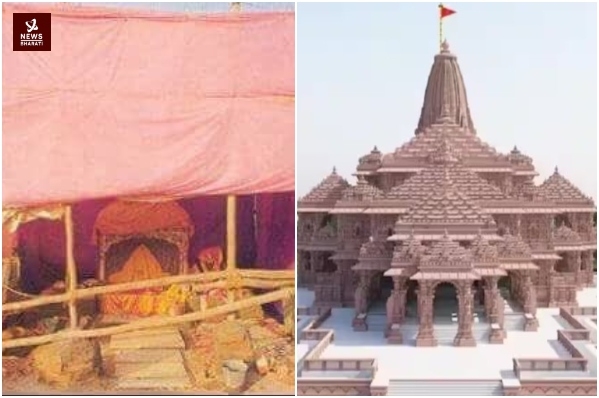Ram Mandir's inauguration, a 500-year-old journey: A timeline of events from 1528 to 2024
13 Jan 2024 12:18:52
The history of Ram Janmabhoomi dates back to more than 500 years of journey that is marked by several significant events. As the nation gears up for the grand Ram Mandir inauguration in Ayodhya on January 22, 2024, let's take a look at the timeline of events:

1528: In 1528, the construction of a mosque at a disputed site was ordered by Mir Baqi, a commander under Mughal Emperor Babur. Hindus contended that the location was the birthplace of Bhagwan Shri Ram and that an ancient temple had previously occupied the site. Hindus claimed that beneath one of the mosque's domes lay the sacred spot of Bhagwan Shri Ram's birth.
1530-1556: Swami Maheshanand along with other sadhus and Jayarajakumari, the queen of Hanswar, with her soldiers, fought against Humayun almost 10 times.
1556 - 1606: Swami Balramacharya continued fighting in 20 wars against Akbar.
1658 - 1707: Aurangzeb had to face Baba Vaishnavdas, Guru Gobind Singh, Kunwar Gopal Singh, Thakur Jagdamba Singh, Thakur Gajraj Singh in 30 battles.
1770 -1814: Raja Gurudutt Singh of Amethi and Rajkumar Singh of Pipra continued the struggle for Shri Ram Temple against Nawab Saadat Ali.
1814-1836: The king of Makarhi fought three wars against Nawab Nasiruddin.
1847-1853: Baba Uddhavdas, Shriramcharan Das and Gonda King Devi Baksh Singh attacked against Wajid Ali Shah in two wars.
1853-1859: In 1853, communal riots erupted around the site where the mosque was built. Following these events, in 1859, the British administration installed a fence around the disputed area. This arrangement permitted Muslims to worship inside the mosque while permitting Hindus to worship in the vicinity of the courtyard.
1949: In 1949, the Ayodhya Ram Janmabhoomi dispute originated on September 23 when idols of Bhagwan Shri Ram were discovered within the mosque. Hindus asserted that Bhagwan Shri Ram had manifested himself at that location. Despite the Uttar Pradesh government's directive for the prompt removal of the idols, District Magistrate KK Nayar cited concerns about potentially offending religious sentiments and inciting violence, expressing his inability to enforce the order.
1950: In 1950, two petitions were submitted to the Faizabad Civil Court—one requesting permission for the worship of Lord Ram on the contested land and the other seeking approval for the installation of idols.
1961: In 1961, the Uttar Pradesh Sunni Waqf Board filed a petition, urging for possession of the disputed land and the removal of idols.
1986: On February 1, 1986, responding to a petition by Umesh Chandra Pandey, a Faizabad district judge, K.M. Pandey granted Hindus permission to worship and issued an order for the removal of locks from the structure.
1992: In 1992, a momentous event unfolded on December 6 when thousands of activists, including those affiliated with the Vishwa Hindu Parishad (VHP) and Shiv Sena, demolished the disputed structure also known as the Babri Masjid. This incident triggered widespread communal riots across the country, resulting in the loss of thousands of lives.
2002: In 2002, the Godhra train burning incident, targeting Hindu activists, sparked riots in Gujarat, leading to the deaths of over 2,000 people.
2009: The formation of the Liberhan Commission followed shortly after the destruction of the Babri Masjid. However, the conclusive report was not presented until 17 years later, when it was submitted to Prime Minister Manmohan Singh on June 30, 2009.
2010: In 2010, the Allahabad High Court divided the disputed land into three equal parts among the Sunni Waqf Board, Ram Lalla Virajman, and the Nirmohi Akhara.
2011: In 2011, the Supreme Court intervened by staying the Allahabad High Court's decision on the Ayodhya dispute.
2017: In 2017, the Supreme Court urged for an out-of-court settlement and implicated several BJP leaders in criminal conspiracy.
2019: In 2019, on March 8, the Supreme Court referred the case for mediation, directing the conclusion of proceedings within eight weeks. Despite the mediation panel presenting its report on August 2, 2019, without reaching a resolution, the Supreme Court commenced daily hearings on the Ayodhya case. After concluding the hearings on August 16, 2019, the verdict was reserved. On November 9, a bench of five judges delivered a verdict in favor of the Ram Janmabhoomi, granting 2.77 acres of the disputed land to the Hindu side and allocating an additional 5 acres separately for a mosque.
2020: In 2020, on March 25, after 28 years, the idols of Ram Lalla were moved from the tent to a fiber temple. Subsequently, on August 5, the groundbreaking ceremony for the construction of the temple occurred, led by Prime Minister Narendra Modi. A trust, named ‘Shri Ram Janmabhoomi Teerth Kshetra’, is looking after the construction of Ram Mandir in Ayodhya, which costs around Rs 1,800
2023-2024: Construction of the grand temple of Ram Lalla in Ayodhya was carried out in full swing. The consecration of the grand temple is scheduled for January 22, 2024, marking the culmination of the decades-long dispute. The worship of Ram Lalla will be conducted in a ceremonious manner during this event, led by PM Modi.
